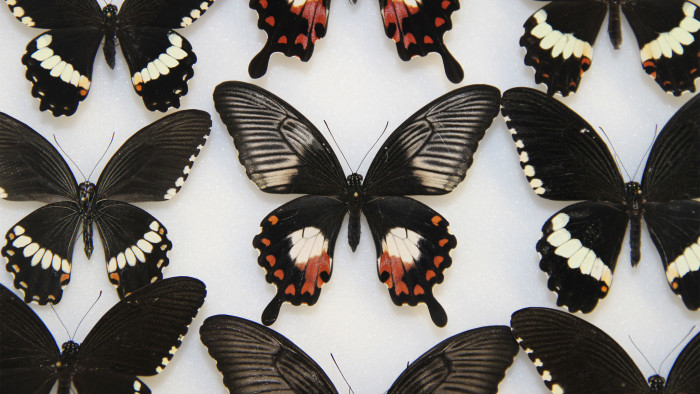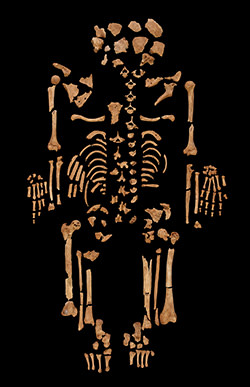Science: The new butterfly effect

Roula Khalaf, Editor of the FT, selects her favourite stories in this weekly newsletter.
Evolutionary biology
Evolutionary biologists have always been fascinated by butterfly mimicry – the way some non-toxic species deter predators such as birds by adopting the wing patterns of unrelated but toxic species. Modern genetics is now beginning to reveal the mechanisms involved.
The new study from the University of Chicago, published in Nature, looks at so-called “sex-limited mimicry” in the Asian swallowtail species Papilio polytes. The females can mimic at least three toxic species, with quite elaborate wing patterns including coloured patches, though sometimes they adopt a non-mimetic form which has simpler black-and-white wings. Males are always non-mimetic.
A prevailing view was that a cluster of genes inherited together – a supergene – must be responsible but the Chicago research disproves this and shows that mimicry is controlled by just one gene involved in sexual differentiation.
“Conventional wisdom says that it should be multiple genes working together to control the whole wing pattern of a butterfly,” says Marcus Kronforst, senior author of the study. “But in this case, it’s just this one [called doublesex or dsx]. This single gene that controls sexual differentiation has been co-opted to do a totally new job.”
The research involved mating hundreds of butterflies with varied wing patterns and looking for DNA differences between mimetic and non-mimetic females, like searching for the genetic cause of a human disease. The process showed that only one gene, dsx, could account for the different patterns.
The DNA that makes up the dsx gene can be cut and rearranged into different forms, as it is translated into active proteins. These “isoforms” not only instruct the embryonic insect whether to be male or female, they can also produce different wing markings. The researchers found that particular isoforms were more active in the wings of developing mimetic butterflies than in non-mimetic females.
Even so, quite how one gene can perform such different functions remains to be discovered. As well as alternative splicing, regulatory regions of the butterfly DNA that do not code for genes may play a role by determining when and whether dsx is active in the developing butterfly.
Co-author Krushnamegh Kunte says future research will determine whether a similar phenomenon has evolved in other species. “We find examples where polymorphisms [different forms of the same species] occur in one sex or the other,” he says. “We’re studying it in the context of mimicry but it’s possible that this sex differentiation pathway found in butterflies could be a pathway that’s more broadly important for sex-limited polymorphism.”
…
Geochemistry: How rocks regulate CO2
For hundreds of millions of years before human industry started pumping carbon dioxide into the atmosphere, natural processes kept CO2 levels in balance so that Earth became neither too hot nor too cold to sustain life. Levels have varied with factors such as volcanic activity, asteroid impacts and solar radiation – but stayed within bounds that are comfortable for biology.
Entomology: Eat, pray, run

Nineteen new species of praying mantis from Central and South America have been identified by the Cleveland Museum of Natural History. The fast-running bark mantises live on tropical trees.
Scientists have long known that a geological carbon cycle, involving the exposure of fresh rock and its gradual weathering, lies at the heart of this long-term climate control but the chemical reactions involved are not well understood. Now researchers at the University of Southern California and Nanjing University in China have published a new chemical interpretation of the process in Nature.
Tectonic activity, which builds new mountains, exposes fresh silicate rock. The silicates react with CO2 and water from the atmosphere, generating silica, calcium and magnesium carbonates and other minerals. This process removes vast quantities of CO2 over millions of years. The geological puzzle is the source of new CO2 to replace it. Some comes from volcanoes but they cannot emit enough to balance the CO2 lost through silicate weathering.
The study suggests that fresh rock exposed by geological uplift can also generate CO2 through sulphide weathering – a different reaction that has the opposite effect to silicate weathering. Minerals such as golden yellow pyrite (iron sulphide) are oxidised to produce sulphuric acid, which in turn reacts with limestone and other carbonate rocks, releasing CO2.
Studying rocks in the Andes, the researchers found that this sulphide weathering yields far more CO2 than scientists had realised previously – and may have played a large role in regulating the atmospheric concentration of CO2 over geological time.
…

Medical archaeology: A skeleton in cancer’s past
The expanding field of medical archaeology – looking for signs of disease in ancient skeletons and other human remains – has turned up lots of evidence for infectious illness such as tuberculosis and leprosy and for injuries caused by accidents and foul play, but little so far for cancer.
This has led some historians of health to think that cancer was rare in the ancient world, both because lifespans were shorter and because people exercised more, ate a healthier diet and encountered less environmental pollution. An alternative view is that cancer was just as common then, adjusting for age, but its prevalence has been hidden by the difficulty of diagnosing cancer in old bodies.
When only skeletons are left, leukaemia, lymphoma and soft tissue tumours are undetectable unless they have affected the bones – which is what happened to an unfortunate young man who lived around 1200BC in what was then Nubia and is now northern Sudan.
Archaeologists from the British Museum and Durham University have made what they say is an unambiguous diagnosis of metastatic bone cancer in his skeleton, excavated last year from Amara West on the Nile. Reported in the journal PLOS One, it is the oldest confirmed case of metastatic cancer.
Scans of the skeleton using radiography and a scanning electron microscope show small lytic lesions (destructive holes) in the bones, which could only have been caused by cancer. This is almost certainly the result of metastasis from a primary tumour in the soft tissues.
The man, aged 25 to 35, was buried in a tomb showing Amara’s hybrid culture of Pharaonic Egypt and Nubia. He was laid on his back in a painted wood coffin with a faience scarab and pottery from the 20th Dynasty. Although the cause of his cancer is unknown, researchers say he would have been exposed to environmental carcinogens. Houses excavated at Amara had hearths for wood-burning fires and there were bread ovens in windowless rooms, so people would have breathed in carcinogenic smoke. Inhabitants also suffered from schistosomiasis, a parasitic infection that increases the risk of bladder cancer.
Even so, says Michaela Binder, bioarchaeologist at Durham, “We do have more negative environmental influences now than they had then,” she says. “But we hope that our find will raise awareness of cancer among archaeologists and that people will look more carefully for evidence.”
New imaging technology can help find tumours in mummified bodies as well as skeletal remains. A thorough search over the next decade might give oncologists a better idea of whether cancer is primarily a modern disease.
…

Olfaction: Humans can smell a trillion odours
How many odours can the human nose distinguish? The conventional total, quoted in scientific literature for almost a century, is 10,000 – but the real number is at least 100 million times higher.
A study at Rockefeller University in New York, published in the journal Science, shows that we can in principle discriminate between more than a trillion different scents.
“Our analysis shows that the human capacity for discriminating smells is much larger than anyone anticipated,” says Leslie Vosshall, lead author. “I hope our paper will overturn this terrible reputation that humans have for not being good smellers.”
Vosshall organised the project because she had long been bothered by the low estimate, which dates back to the 1920s and is not backed by any data. Three light receptors in the human eye can distinguish around 5 million colours, and our ear can distinguish around 340,000 audible tones, so the odour estimate seemed intuitively far too low.
Testing odour discrimination is far more difficult than assessing vision or hearing, because colours and sounds vary along a single dimension – frequency – while smells have a large number of odorant molecules mixed in different proportions.
So Vosshall and her colleague Andreas Keller designed a study based on sampling. They concocted random mixtures of 128 odorant molecules and gave volunteers three scent vials at a time: two identical and one different. Subjects had to pick out the vial that smelled different from the others. They concluded that an average person could distinguish a trillion combinations of the 128 molecules.
Indeed they say their “conservative” estimate of a trillion is probably too low. “We were all surprised at how ridiculously high even the most conservative lower estimate is,” Vosshall says. “But there are many more than 128 odorants and so the actual number will be much bigger.”
Individuals are not exposed to trillions of different smells on a daily basis, she adds, but “with a sensory system that is so complex we are ready for anything”.
To comment on this article please post below, or email magazineletters@ft.com
Comments